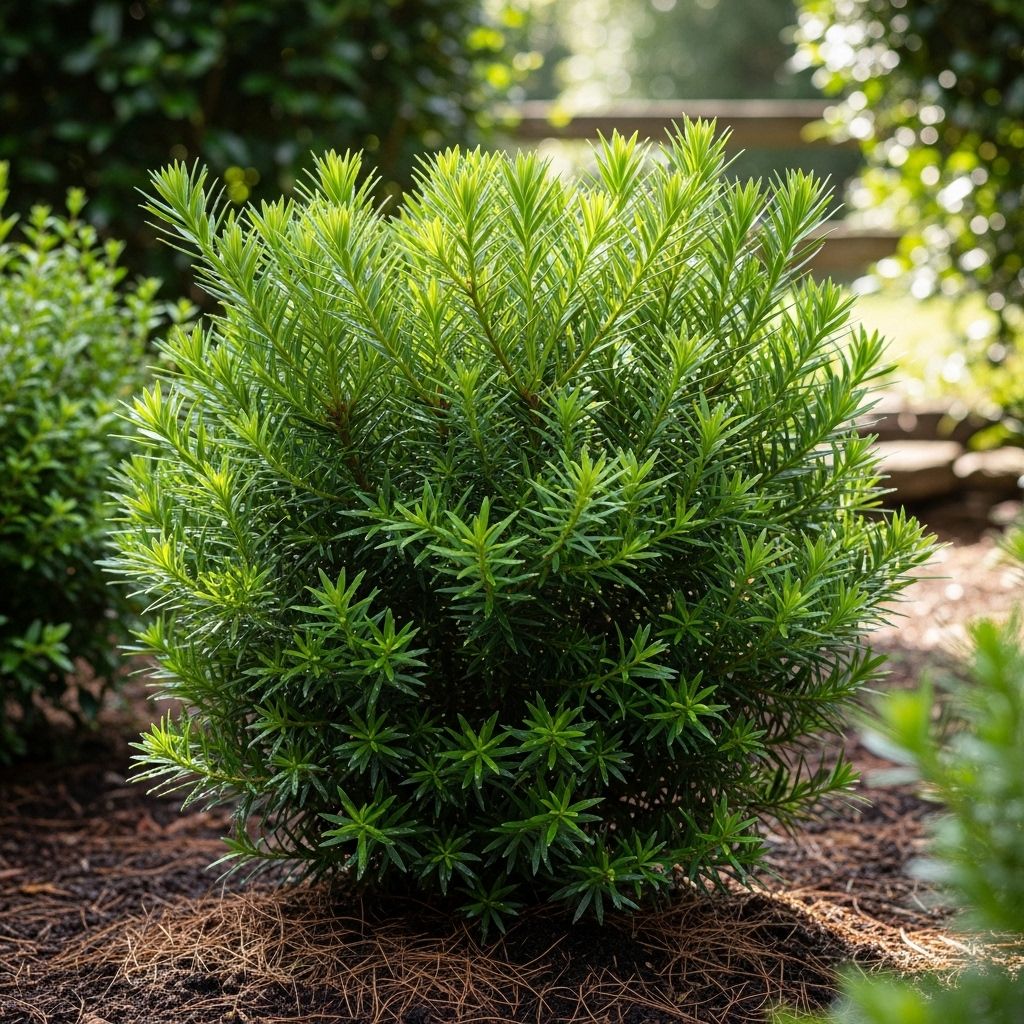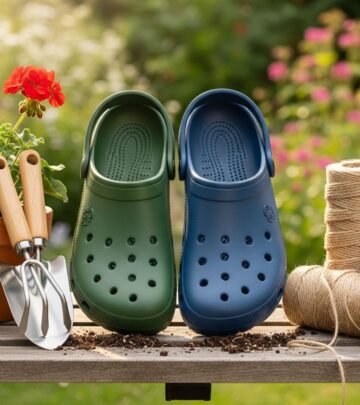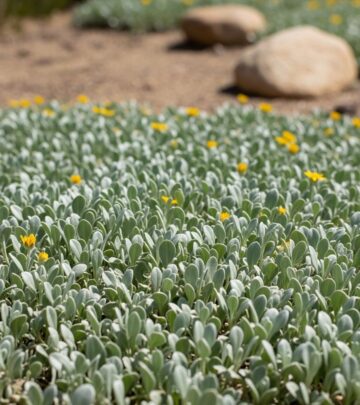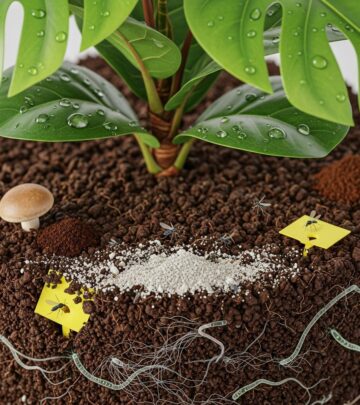Podocarpus Care Guide: Essential Tips For Thriving Evergreens
Discover the beauty, versatility, and care essentials of Podocarpus, an adaptable evergreen for hedges, privacy, and garden design.

Image: HearthJunction Design Team
Gardening 101: Podocarpus—A Versatile Evergreen for Every Landscape
Podocarpus, commonly called the plum yew or Buddhist pine, is a genus of evergreen shrubs and trees prized for their elegant form, lush foliage, and remarkable versatility. Admired throughout the gardening world, Podocarpus finds a natural place in a wide range of settings—from sculpted urban hedges to woodland retreats. In this comprehensive guide, you’ll learn about the best varieties, landscape uses, planting and care tips, common problems, and expert advice for growing Podocarpus successfully.
What Is Podocarpus?
Belonging to the Podocarpaceae family, Podocarpus is a genus containing numerous species of conifers. Podocarpus species are mainly native to Asia, Africa, and parts of the Americas, thriving in warm climates and celebrated for their adaptability.
- Hardy in USDA Zones 8–11 (some types Zone 9–11)
- Evergreen, retaining foliage year-round
- Various forms from compact shrubs to towering trees up to 80 feet
- Low-maintenance and highly deer-resistant
One of the genus’s main attractions is its range of aesthetic options: from arching, lush green fronds to stylish blue-grey needles. Whether you crave a modern clipped look or a soft, feathery privacy screen, there’s a Podocarpus for you.
Standout Podocarpus Varieties
- Podocarpus gracilior (now called Afrocarpus gracilior): A fast-growing, dense evergreen capable of reaching 40 feet tall. Popular as both specimen trees and hedges, their slender, arching foliage creates a graceful silhouette.
- Podocarpus elongatus ‘Monmal’: A striking large shrub or small tree, slowly growing to 15–25 feet. Known for dusky blue-grey foliage and robust cold-tolerance (USDA Zones 9–11). An excellent choice for statement hedges or accents.
- Podocarpus latifolius: This slow-growing, upright tree can reach 40 feet in gardens. Its narrow form and silver-blue leaves work well in both sun and partial shade. A favorite for narrow spaces and formal designs.
- Mood Ring® Podocarpus: An upright hybrid with bronzy-pink new growth that matures to deep green. It is heat- and sun-tolerant, disease- and deer-resistant, and makes an easy-care hedge or specimen plant.
Landscape Uses: Where Podocarpus Excels
Few plants are as adaptable as Podocarpus. Whether your garden style is sleek and modern, lush and tropical, or informal and cottage-inspired, Podocarpus fits right in. Here’s how gardeners are using this versatile evergreen:
- Hedges & Privacy Screens: Their dense growth offers year-round privacy and wind protection. Clip for formal, geometric hedges, or let grow for a relaxed, natural look.
- Specimen Trees & Focal Points: Left unpruned, taller species become beautiful shade trees or striking solo specimens.
- Windbreaks: Their sturdy structure and evergreen foliage make Podocarpus excellent for protecting sensitive plants from harsh winds.
- Topiary & Formal Designs: Podocarpus responds well to pruning. Create balls, cones, columns, or even espalier along walls and fences.
- Containers: Dwarf forms suit large patio pots, lending year-round structure and elegance.
- Urban, Suburban, or Rural: Podocarpus adapts seamlessly to a range of environments and design schemes.
Cheat Sheet: Podocarpus at a Glance
- Perfect for evergreen hedges, privacy screening, windbreaks, or as a focal point
- Low-maintenance, adaptable to different garden styles
- Highly deer-resistant
- Forms range from tight balls to airy, arching trees
- Toxic to pets (stems, leaves, flowers, pollen)
Why Podocarpus? Comparing with Other Shrubs
Many gardeners turn to boxwood for structure, but Podocarpus offers similar form with added benefits. As expert Matthew Pottage from the RHS remarks:
“I have a soft spot for podocarpus. The different varieties have great garden use. You can clip them and shape them; they have small leaves. They are yet to have their time.”
| Feature | Podocarpus | Boxwood |
|---|---|---|
| Deer Resistance | Very high | Moderate to low |
| Maintenance | Low | Moderate |
| Pruning Styles | Versatile; tolerates shearing | Versatile |
| Disease Issues | Few; occasional aphids | Prone to blight |
| Growth Rate | Medium to fast | Slow |
If you want dense greenery with less disease risk and greater deer-resistance, Podocarpus stands out as a superior modern alternative to boxwood and other traditional hedge choices.
Planting & Care: Tips for Thriving Podocarpus
Site Selection
- Sun: Prefers full sun; tolerates partial shade
- Soil: Well-drained soil is crucial; loamy or sandy soils are best
- Drainage: Avoid areas with standing water or poor drainage—wet feet cause root rot
Planting Instructions
- Dig a hole twice as wide and just as deep as the rootball.
- Mix native soil with compost for added nutrition.
- Set the plant at the same depth as it grew in the nursery container.
- Backfill gently and water thoroughly.
- Apply mulch to conserve moisture and suppress weeds, but keep it away from the stem.
Watering & Fertilizing
- Water deeply after planting; maintain moist (not soggy) soil while establishing for 6–12 months.
- Once established, Podocarpus is drought-tolerant and requires minimal supplemental water.
- Fertilize annually in early spring with an all-purpose slow-release fertilizer.
Pruning & Shaping
- Podocarpus responds well to regular trimming. Clip for shape, density, or to maintain size.
- For formal hedges, prune tops narrower than the base (trapezoid shape) to maximize sun exposure and healthy growth.
- For informal screens, prune only as needed to remove stray branches and maintain character.
- Topiary and espalier forms are achievable for creative gardeners.
Design Inspiration: Creative Ways to Use Podocarpus
Podocarpus is a designer’s dream. Here’s how landscape architects and home gardeners are making the most of its adaptable nature:
- Modern Minimalism: Tall, narrow columns as a backdrop to patio seating or flanking a pathway.
- Cottage Charm: Looser, arching forms blended with flowering shrubs and perennials.
- Woodland Gardens: Podocarpus underplanted with ferns and shade-tolerant groundcovers for a layered look.
- Urban Oasis: Dense hedges to block out street views while adding elegant structure and greenery.
- Espalier or Living Walls: Trained flat against fences or walls to save space and add greenery where horizontal space is limited.
Potential Issues: Pests, Diseases, and Toxicity
Pests
- Podocarpus Aphids: These blue-purple insects may cause leaf curling on new growth. Control with insecticidal soap applied as directed for spot treatments.
Diseases
- Root Rot: Occurs in soggy or poorly-drained soils. Prevent by ensuring excellent drainage and amending soil as needed.
Toxicity
- All parts of Podocarpus contain toxins, including stems, leaves, flowers, and pollen.
- Ingestion by pets or children can cause adverse effects; always plant responsibly.
Expert Tips for Podocarpus Success
- Space plants at least 4 feet apart when creating a living screen for best results and reduced disease risk.
- Plan hedge shapes in advance—prune with the base wider than the top to ensure lower foliage stays healthy.
- Podocarpus tolerates drought, heat, wind, and some salt once mature, making it ideal for tough spots.
- If you want rapid coverage, choose faster-growing species and water well the first year.
- Call local utility services before digging to avoid underground line damage—especially important with hedges and large installations.
Frequently Asked Questions (FAQs)
Q: Is Podocarpus a good hedge plant?
A: Yes, Podocarpus makes an exceptional hedge due to its dense, evergreen foliage, fast growth, and ease of pruning. It adapts well to formal and informal designs.
Q: How tall and wide does Podocarpus grow?
A: Depending on species, Podocarpus may reach from 3 feet tall (dwarf forms) to 80 feet (tree forms). Hedges and screens are often maintained 6–20 feet, while trees grow much taller when unpruned.
Q: Is Podocarpus poisonous to pets?
A: Yes. All parts of the plant (leaves, stems, flowers, pollen) are considered toxic to pets and humans if ingested. Always plant with caution in areas accessible to children and animals.
Q: How do I prune Podocarpus for a neat hedge?
A: Prune after spring growth. Shape with the base wider than the top for even sunlight. Remove stray shoots regularly. For more natural screens, prune only as needed.
Q: Are Podocarpus plants drought-tolerant?
A: Once established, most varieties are highly drought-tolerant and require little supplemental irrigation.
Q: Does Podocarpus require special soil?
A: Podocarpus prefers well-drained soil. It tolerates a variety of soil types, but will not thrive in consistently wet or poorly drained areas.
Final Thoughts
Few plants offer the versatility, beauty, and reliability of Podocarpus for today’s modern gardens. Whether you’re aiming for a manicured hedge, a towering privacy screen, or an artful topiary, this adaptable evergreen delivers year-round interest with minimal fuss. Blend Podocarpus into your landscape and discover why designers and homeowners alike are singing its praises.
References
- https://www.gardenista.com/posts/gardening-101-podocarpus/
- https://www.gardenista.com/posts/hardscaping-101-decomposed-granite/
- https://southernlivingplants.com/the-collection/plant/mood-ring-podocarpus/
- https://www.gardenista.com/posts/landscape-ideas-boxed-boxwood-5-shrubs-try-instead/
- https://blogs.ifas.ufl.edu/charlotteco/2022/11/17/the-multipurpose-podocarpus/
Read full bio of Shinta












